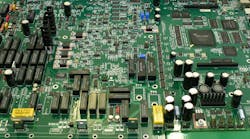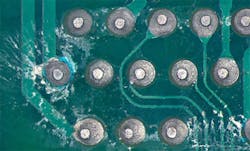Most assemblers in the electronic industry use no-clean solder paste mainly to eliminate having to clean the circuit-board assemblies. Manufacturers such as Rush PCB prefer to run all production with the same process and, therefore, also use no-clean flux, for which they have developed and fine-tuned their assembly processes. Assemblers would rather clean only the printed-circuit boards (PCBs) that require it instead of adapting processes that accommodate different types of solder paste.
No-clean solder paste generally doesn’t require cleaning. Assemblers find it more difficult to remove the flux residue that no-clean pastes leave behind, as compared to flux from other types of solder pastes. Cleaning such trace residue creates a problem, because their designs don’t allow them to wash off easily (see figure).
In reality, no-clean solder paste leaves behind flux with low residue. The reflow process leaves trace amounts of resinous residue, noncorrosive in nature. Present on or around solder joints, the residue can vary in color from amber to transparent. The residue left on the board after reflow depends directly on the solid content in the solder paste, mainly made up of activators, gelling agents, and resins.
Why Clean No-Clean Flux
Problems occurring during in-circuit testing led to assemblers resorting to cleaning boards soldered with no-clean paste. Earlier generation of no-clean pastes produced tacky residues after reflow, and test pins didn’t always penetrate fully to make good electrical contact with respective test pads. Furthermore, pins had residue building up on them that affected their accuracy, requiring periodic maintenance. However, the latest generation of no-clean pastes don’t suffer from these problems.
Assemblers clean no-clean fluxes under certain conditions, such as:
- For circuits with clock speeds above 1 GHz, to prevent circuit malfunction.
- For improving adhesion of conformal coating and underfill materials—flux residues are mostly hydroscopic and may generate small amounts of gas or steam during curing, thereby affecting adhesion and integrity.
- For improving overall cosmetic appearance by removing small particles such as solder balls.
With PCBs becoming increasingly complicated, and designers packing them more tightly, soldering with no-clean paste doesn’t always work very well. As demand for miniature electronics grows, manufacturers are using flip-chips, micro ball-grid array (BGAs), quad-flat no-leads (QFN) packages, and chip-scale packaging (CSP) components in smaller spaces on boards.
Such a trend in miniaturization, high density, and complexity tends to cause issues if the boards aren’t clean. PCBs with flux residue may face problems such as parasitic leakage, dendrite growth, electrochemical migration, and shorting. Therefore, cleaning the no-clean flux residue is no longer an optional process; rather it’s now indispensable for long-term PCB reliability, functionality, and performance.
Although development of no-clean fluxes was to avoid the need for cleaning PCBs post-reflow, they now represent one of the greatest challenges in cleaning PCBs. No-clean fluxes contain salt activators that when coming in contact with other chemicals and in the presence of heat, create a whitish residue, helping to corrode fragile circuitry and enabling growth of dendrites.
How to Clean No-Clean Flux
Simple water can’t clean the flux residue left behind by no-clean solder paste—it requires a solution of saponifier in water. Assemblers determine the most effective cleaning process to employ based on the chemistry of the flux they’re using, whether the residue is hard or soft, and whether the solids in the flux are in low or high amounts.
Fluxes with halides generally leave more residue, but assemblers can clean them easily with mild cleaning agents and using short wash times. On the other hand, halide-free no-clean fluxes don’t leave much residue behind, but are more difficult to clean.
No-clean solder pastes exposed to high temperatures are likely to oxidize and leave hard residues and create dull solder joints. Rush PCB recommends following the instructions of the paste manufacturer for the best soldering experience.
Cleaning Lead-Free No-Clean Flux
Because reflow temperatures for melting lead-free solder are typically 240-250°C, the residue lead-free no-clean pastes leave behind are hard and difficult to clean. Thus, process engineers must resolve the cleaning issues before the assembler adds other material such as coatings. Rush PCB recommends selecting pastes that are easier to clean, as this improves the quality of the PCB.
How Cleaning No-Clean Flux Helps
With the increasing complexity of modern PCBs, assemblers prefer to clean all PCBs, and not just those with high density. This prevents unpredictable performance in the field, expensive board failures, product recalls, and product returns.
The primary intention for removing the no-clean flux and its residue from the board surface is to prevent interference with signal transmission and malfunction in circuit functioning. This is true not only for boards with high-frequency circuits, but also for boards with high-voltage systems as well as high-impedance systems.
Tightly packed components often trap balls of solder between them. There may be additional contaminants on the board, such as ink and fingerprints. While cleaning, along with no-clean flux residue, assemblers clean other contaminants, too, resulting in optimal board performance.
Cleaning the board surface has additional benefits such as improved cosmetic appearance. This allows for easier inspection and quality control. On top of that, a clean board surface allows for better adherence of conformal coatings.
For high-reliability boards, especially those intended for military or medical applications, cleanliness is a critical factor. Other applications such as aerospace also have stringent requirements about cleaning.
Selecting No-Clean Flux Removers
Numerous no-clean flux removers are available in the market, and their strengths vary. Selecting a suitable no-clean flux remover requires matching the fluid to the contaminant. The cleaning fluid must also be compatible with the substrate of the PCB and other materials on it. Ideally, the cleaner must be adequately strong to remove the flux residue effectively, but not damage the plastics, metal, or coatings.
Workplace safety demands the use of a non-flammable no-clean flux remover. In addition, Rush PCB recommends the use of a cleaning-fluid dispensing tool. This helps to scrub the contaminant from the hands of workers, thereby regulating their exposure to the amounts of fumes and fluids.
Conclusion
Rush PCB can help in determining the most suitable cleaning fluid or the optimum method of use. Our experience in manufacturing PCBs has helped in building up experience and expertise in this field, which we share with our customers in helping them get the best deal for their project.
Akber Roy is CEO of Rush PCB.

